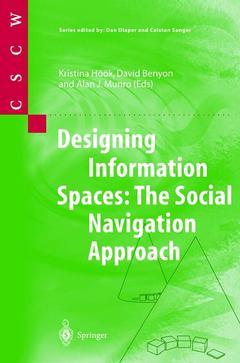Description
Designing Information Spaces: The Social Navigation Approach, Softcover reprint of the original 1st ed. 2003
Computer Supported Cooperative Work Series
Language: English
Subject for Designing Information Spaces: The Social Navigation Approach:
Publication date: 12-2002
456 p. · 15.5x23.5 cm · Hardback
456 p. · 15.5x23.5 cm · Hardback
Description
/li>Contents
/li>Comment
/li>
That's a look at an array of social proxies. The purpose was to make it clear that the concept of social proxy is quite general. Social proxies can be designed to support a wide range of on-line interactions, whether they involve conversation or not. They may be synchronous or asynchronous, and they may be associated with activities which are an end in them selves (e. g. auctions), or activities which are simply a means to an end (e. g. waiting in queues). We believe that by providing a shared represen tation of the activity in which participants are involved, social proxies can help create shared expectations, shared experiences, and can serve as a resource which participants can use to structure their individual and collective interactions. That is, at least, our claim. However, it is important to note that, except for the first, the proxies described so far are concept pieces, meaning that they haven't been implemented and deployed to real situations. Now, however, we will turn to an implemented system, and look at a real example. 1. 4 Experience: The Babble System In the previous section we introduced the concept of social proxies and discussed examples illustrating the wide range of situations to which social proxies can be applied. In this section, we focus on our experience in designing, implementing and studying a social proxy in the context of an on-line system called Babble.
Editors’ Introduction: Footprints in the Snow.- I Systems and Theories.- 1 Social Translucence: Using Minimalist Visualisations of Social Activity to Support Collective Interaction.- 2 Collaborative Filtering: Supporting Social Navigation in Large, Crowded Infospaces.- 3 Screen Scenery: Learning from Architecture and People’s Practices of Navigation in Electronic Environments.- 4 Navigating the Virtual Landscape: Coordinating the Shared Use of Space.- 5 Experiential Design of Shared Information Spaces.- 6 GeoNotes: A Location-based Information System for Public Spaces.- 7 Footsteps from the Garden: Arcadian Knowledge Spaces.- 8 Social Navigation of Food Recipes: Designing Kalas.- 9 Results from the Footprints Project.- 10 WebPlaces: Using Intermediaries to Add People to the Web.- II Theories and Principles.- 11 Where the Footprints Lead: Tracking Down Other Roles for Social Navigation.- 12 Social Connotations of Space in the Design for Virtual Communities and Social Navigation.- 13 Informatics, Architecture and Language.- 14 Information that Counts: A Sociological View of Social Navigation.- 15 Navigation: Within and Beyond the Metaphor in Interface Design and Evaluation.- 16 The Conceptual Structure of Information Space.- 17 Information Space Navigation: A Framework.- References.
This is the only major work covering this important topic Includes supplementary material: sn.pub/extras
© 2024 LAVOISIER S.A.S.

